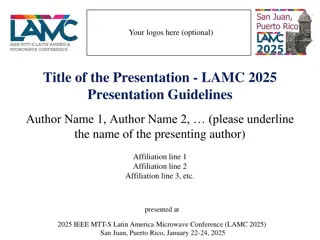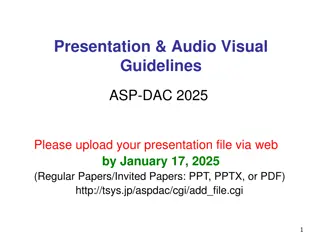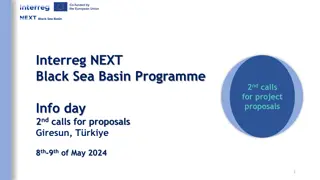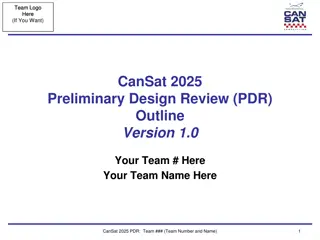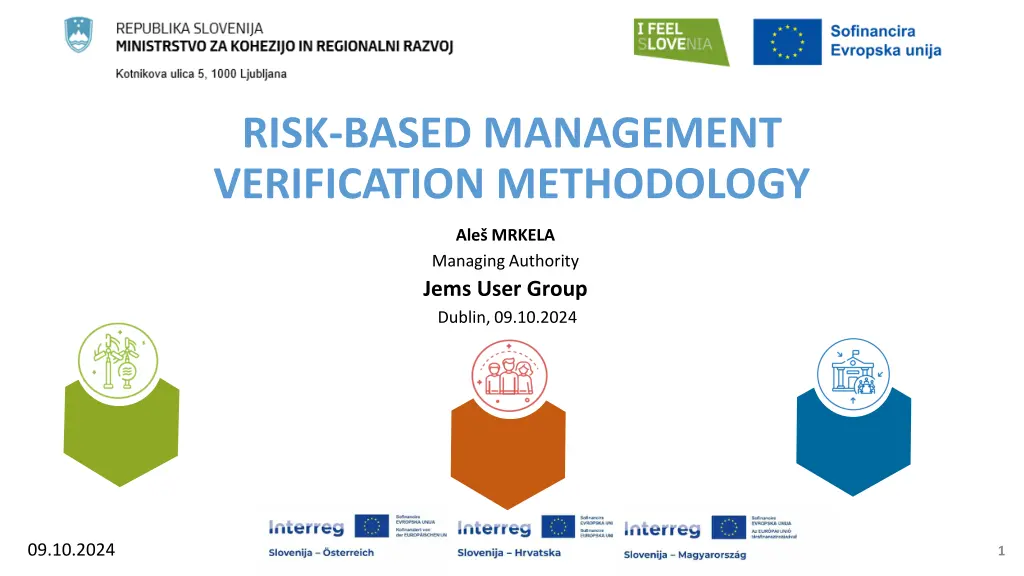
Risk-Based Management Verification Methodology for Project Oversight
Explore the Risk-Based Management Verification Methodology for efficient project oversight and compliance. Learn about legal basis, data collection, verification processes, and risk identification. Enhance your understanding of RBMV for standard and small-scale projects.
Download Presentation

Please find below an Image/Link to download the presentation.
The content on the website is provided AS IS for your information and personal use only. It may not be sold, licensed, or shared on other websites without obtaining consent from the author. If you encounter any issues during the download, it is possible that the publisher has removed the file from their server.
You are allowed to download the files provided on this website for personal or commercial use, subject to the condition that they are used lawfully. All files are the property of their respective owners.
The content on the website is provided AS IS for your information and personal use only. It may not be sold, licensed, or shared on other websites without obtaining consent from the author.
E N D
Presentation Transcript
RISK-BASED MANAGEMENT VERIFICATION METHODOLOGY Ale MRKELA Managing Authority Jems User Group Dublin, 09.10.2024 09.10.2024 1
LEGAL BASIS and SUPPORTING DOCUMENTS Article 74(1)(a) and 74(2) of the CPR Reflection Paper of the EC: RBMV 2021-2027 Guidance on the RBMV for 2021-2027 and HIT methodology 09.10.2024 2
PREPARATION of RBMV Workshop in Bohinj - January 2024 Representatives from three CBC programmes External expert Brainstorming 09.10.2024 3
COLLECTING THE DATA for RBMV HOW?: Excel sheet WHO?: Joint Secretariat/National Controllers WHEN?: Each year after the approval of the Annual Accounts WHERE?: Jems (eMS), Self-declaration by PPs 09.10.2024 4
RBMV WHO/WHICH LEVEL? Standard projects: partner level: National Controllers project level: Joint Secretariat Small-scale projects: partner level: Joint Secretariat (HU NC for SI-HU) project level: Joint Secretariat 09.10.2024 5
RMBV National controlers verification HOW?: Automatised in Jems WHEN? Latest till end of June 2024 WHAT? Partner reports + OTS RISK-BASED MANAGEMENT VERIFICATION AND CONTROL MANUAL 09.10.2024 6
RBMV Methodology STANDARD PROJECT -RBMV - based on Risk factors SMALL-SCALE PROJECT - RBMV - 100% check 09.10.2024 7
RBMV Methodology for STANDARD PROJECTS 09.10.2024 8
RISK IDENTIFICATION Risks Risks description Operation not completed and/or not functional 1. Products and services not delivered ineligible project Operation not compliant with initial plan (time, quantity, quality) Missing evidence for indicators Wrong application of PP procedures (artificial splitting and/or non-sufficient publicity) 2. Laws and conditions of support not respected Not correctly recognised state aid Unlawful changes Missing documents (permits) Indirect costs declared as direct cost 3. Ineligible Expenditures and non-sufficient audit trail and accounting Wrong declaration % of staff costs Double-funding, missing documents Inflated staff costs 4. Simplified cost options conditions for payment not respected Condition for support not respected: Activities, deliverables, outputs, results 09.10.2024 9
No. Risk criteria (RC) Source of data Staff with working time on the project (per person) <= 15% Number of operations run in parallel by partners (per ID/TAX number) Change of contractor / sub-contractor(s) Are PP activities State aid/de-minimis relevant Did the PP activities become State aid/de- minimis relevant during past year 1 JS: JEMS - manually JS: self-declaration filled in by all PPs - manually NC: JEMS - manually JS: JEMS (check list for State aid/de- minimis) manually JS: JEMS (check list for State aid/de- minimis) - manually JS manually 2 3 SCORING OF THE RISKS AT PARTNER LEVEL 4 EACH RISK IS QUANTIFIED FROM -3 TO 5 5 Amount of financial errors detected by FLC on PP level in previous financial period 2014- 2020 within the relevant programme Annual summary of controls background tables from eMS (history) JS manually 6 Amount of financial errors detected by NC on PP level in sampled expenditures in 2021- 2027 within the relevant programme based on previous confirmed PP reports and errors detected - background tables from JEMS 7 09.10.2024 10
No. Risk criteria (RC) Source of data JEMS - automatically 8 Number of staff per PP count staff rows JEMS - automatically 9 Use of the 40% staff cost flat rate flat rate 40% selected SCORING OF THE RISKS AT PARTNER LEVEL JEMS - automatically EACH RISK IS QUANTIFIED FROM -3 TO 5 Planned External services related to contract > 10.000 EUR 10 any expenditure in total price per row exceeds 10.000 EUR JEMS - automatically Planned amount of external expenditures of smaller (<10.000 EUR) exceeds 70% of total external expenditures sum of total cost in rows below 10.000 exceeds 70% of total external expenditures in category 11 JEMS - automatically Planned Equipment related to contract > 10.000 EUR 12 any expenditure in total price per row exceeds 10.000 EUR 09.10.2024 11
CONTENT OF THE SCORING Planned Amount of equipment expenditures of smaller (<10.000 EUR) exceeds 70% of total equipment expenditures No. Risk criteria (RC) Source of data JEMS - automatically sum of total cost in rows below 10.000 exceeds 70% of total equipment expenditures in category JEMS - automatically 13 SCORING OF THE RISKS AT PARTNER LEVEL 14 Existence of investments in infrastructure row infrastructure and works exists JEMS - automatically EACH RISK IS QUANTIFIED FROM -3 TO 5 Duration of the activities (in reporting periods) 15 end period minus start period JEMS - automatically realization per partner budget till reporting minus planned partner budget till planned reporting > 0 JEMS - automatically 16 Underspending realization per partner budget till reporting minus planned partner budget till planned reporting > 0 17 % of underspending 09.10.2024 12
LEVEL OF RISK Score 0-7 8-20 21 or more PARTNER LEVEL Risk low medium high 09.10.2024 13
Frequency and Coverage partner level Level of risks on partner level/ checks Desk based: low medium high At each report Frequency Desk based: FREQUENCY AND COVERAGE min 35% of total costs declared in PP report min 50% of total costs declared in PP report min 75% of total costs declared in PP report Coverage/Expenditures including those checked 100% (Costs) up to the L/M/H risk PARTNER LEVEL OTS: Frequency/ Number of project partners to be checked according to the level of risk OTS: 5% 15% 30% In line with the OTS checklist Coverage (What to check?) 09.10.2024 14
WHAT TO CHECK? 100% mandatory checks are obligatory in the cost categories: - External services (related to planned contract value above 40.000 EUR) - Equipment (related to planned contract value above 40.000 EUR) - Infrastructure and works No checks are foreseen for the indirect costs in the cost categories: - Office and administrative costs - Preparatory costs - Travel and accommodation - Other costs 09.10.2024 15
No. Risk criteria (RC) Source of data Number of operations run in parallel by partners (per ID/TAX number) JS: self-declaration filled in by all PPs - manually 1 Change of contractor / sub-contractor(s) JS: JEMS - manually 2 SCORING OF THE RISKS AT PROJECT LEVEL Are PP activities State aid/de-minimis relevant JS: JEMS (check list for State aid/de- minimis) - manually EACH RISK IS QUANTIFIED FROM -3 TO 5 3 Did the PP activities become State aid/de- minimis relevant during past year JS: JEMS (check list for State aid/de- minimis) - manually 4 JS: JEMS (SAG) - manually Quality of partnership score of assessment 5 JS: JEMS (SAG) - manually Quality of budget score of assessment 6 09.10.2024 16
No. Risk criteria (RC) Source of data JS manually Amount of financial errors detected by JS on Project level in previous financial period 2014-2020 within the relevant programme 7 Annual summary of controls background tables from eMS (history) JEMS - automatically 8 Number of deliverables SCORING OF THE RISKS AT PROJECT LEVEL number of deliverable rows in project EACH RISK IS QUANTIFIED FROM -3 TO 5 JEMS - automatically 9 Number of staff working per project count staff rows per project (sum PP staff rows) JEMS - automatically Number of accepted changes (no. of application versions) 10 version of application JEMS - automatically 11 Existence of investments in infrastructure row infrastructure and works exists in any project partner JEMS - automatically 12 Size of the project total project budget 09.10.2024 17
No. Risk criteria (RC) Source of data JEMS - automatically 13 Number of PP number of PPs JEMS automatically Duration of the project in periods - up to the programme 14 number of periods SCORING OF THE RISKS AT PROJECT LEVEL EACH RISK IS QUANTIFIED FROM -3 TO 5 JEMS - automatically realization per project budget till reporting minus planned project budget till planned reporting > 0 15 Underspending JEMS - automatically realization per project budget till reporting minus planned project budget till planned reporting > 0 16 % of underspending 09.10.2024 18
Score 0-10 11-28 29 or more LEVEL OF RISK PROJECT LEVEL Risk low medium high 09.10.2024 19
Frequency and Coverage project level low Level of risks on project level/ checks medium high Based on submission: Desk based: Based on submission: Based on submission: Frequency / Project reports to be checked according to the L/M/H risk (risks shall be defined for all projects consisting of a pool of projects in risk group) Every 5thproject report submitted from the pool of low- risk projects Every 3rdproject report submitted from the pool of medium-risk projects Every 2ndproject report submitted from the pool of high-risk projects FREQUENCY AND COVERAGE Desk based: In line with the JS checklist Coverage (What to check?) SSV: PROJECT LEVEL Defined once a year after RBMV exercise Defined once a year after RBMV exercise Defined once a year after RBMV exercise Frequency/ Percentage of projects to be checked according to the level of risk from the pool of projects in risk group SSV: 10% 25% 50% In line with the SSV checklist Coverage (What to check?) 09.10.2024 20
RBMV Methodology for SMALL - SCALE PROJECTS 09.10.2024 21
Frequency and Coverage project level Desk based: Frequency / Project reports to be checked: - all projects from a pool of projects have the same risk factor the pool of projects is consisting of all contracted projects from each SSP submission deadline Desk based: Automatically - randomly chosen 80 % of all projects. - FREQUENCY AND COVERAGE In line with the JS checklist for SSP Coverage (What to check?) SSV*: Frequency/ Projects to be checked: PROJECT LEVEL Automatically - all projects that were not desk-based checked (20%). - all projects from a pool of projects have the same risk factor the pool of projects is consisting of all contracted projects from each SSP submission deadline SSV: - In line with the SSV checklist for SPP Coverage (What to check?) 09.10.2024 22
FROM THEORY TO PRACTICE 09.10.2024 23
CONSIDERATIONS Where shall the data be stored JEMS or any other system Where do we take data from JEMS, manually, Keep, Arachne, other Which programming language to use is there a framework What personnel do we have for implementation internal/external How flexible we can be Do we touch the Core JEMS Timing and cost of implementation What we have and can we build on top of that 09.10.2024 24
CONCRETE ANSWERS We implemented some plugins in JEMS that are pretty standard We did some Exports in JEMS, but only for paper visualization We did produce an Aggregator tool that uses API for data We already take data from JEMS and put it in aggregator database We added models in own database for usage of data We have dedicated servers for own implementations We don t know what additional functions can we expect in JEMS Aggregator app gives us more flexibility as we know development timeline 09.10.2024 25
DECISION Create as much as possible in Aggregator (fast, secure, easy framework) Query Aggregator via API Take data from JEMS and turn it around in Aggregator application (presentation layer) Modify plugins so that they interface with Aggregator app 09.10.2024 26
PROCESS WORKFLOW OF RBMV We added items that are not present in JEMS to Aggregator (risks, scores, different programmes, unique identifiers ) When report starts to be checked plugin in JEMS asks Aggregator API for selection of invoices Aggregator asks JEMS to send him all the updated data and selects items for the verification based on presented methodology Aggregator sends to JEMS data to be selected JEMS plugin selects data in JEMS database so the controller can see them properly Similar process is implemented also at the level of Project reports with a contentwise difference sampled item doesn t have to be checked 09.10.2024 27
09.10.2024 28








